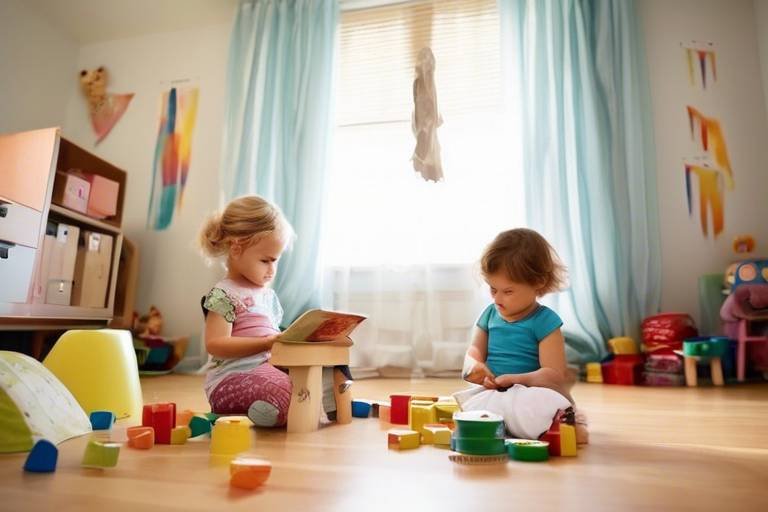Exploring Family Dynamics: An Insightful Study
Family dynamics are like the intricate threads of a tapestry, weaving together the emotions, behaviors, and relationships that define our lives. They shape who we are, influencing our decisions, our interactions with others, and even our mental health. Have you ever noticed how your family’s way of communicating can affect your friendships or romantic relationships? Understanding family dynamics is not just an academic exercise; it's a vital part of grasping how we function as individuals within a community. In this article, we will dive deep into the complexities of family relationships, examining their influences, structures, and the myriad factors that contribute to family dynamics across different cultures and societies.
Why should we care about family dynamics? Well, think of family as the first social unit we interact with. From the moment we’re born, our family shapes our worldview, our values, and our emotional responses. The way family members communicate, resolve conflicts, and support each other can have profound implications on mental health and overall well-being. For instance, a nurturing family environment can foster resilience, while a dysfunctional one may lead to a range of emotional challenges. In essence, understanding family dynamics is crucial because it not only impacts individual behaviors but also influences broader societal interactions. When families thrive, communities flourish.
Families come in various forms, each with its unique characteristics and challenges. Understanding these structures helps us appreciate the diversity of family dynamics. Here are some common types of family structures:
- Nuclear Families: Consisting of two parents and their children, this is the most recognized family unit.
- Extended Families: These include additional relatives, such as grandparents, aunts, uncles, and cousins.
- Blended Families: Formed when one or both partners have children from previous relationships.
Each of these family types brings its own set of dynamics that can influence relationships, communication styles, and emotional support systems. In the following sections, we will explore these structures in more detail.
Nuclear families, often seen as the traditional family model, consist of two parents and their children living together. This structure has been the cornerstone of many societies for generations. But what makes nuclear families tick? On one hand, they provide a focused environment where parents can nurture their children closely. This often leads to stronger parent-child relationships, as parents can dedicate their time and resources to their immediate family. However, nuclear families are not without their challenges. They can sometimes feel isolated from extended family support, leading to increased pressure on parents. In today’s fast-paced world, this isolation can amplify stress levels and impact the overall family dynamic.
The benefits of nuclear families are significant. They often create a stable environment for children, allowing them to thrive emotionally and academically. The focused attention from parents can lead to:
- Stronger emotional bonds between parents and children.
- More effective communication and conflict resolution.
- A structured environment that fosters discipline and responsibility.
These advantages can set the stage for healthier adult relationships, as children learn valuable life skills from their parents.
However, it’s essential to recognize the challenges that nuclear families face. The pressure to maintain a perfect family image can lead to stress and anxiety. Common struggles include:
- Feelings of isolation from extended family.
- Financial pressures that can strain relationships.
- Balancing work and family life effectively.
Addressing these challenges requires open communication and a willingness to seek support from outside the immediate family unit.
Extended families, which include relatives beyond the nuclear unit, play a crucial role in family dynamics. They often serve as a support network, providing emotional and practical assistance. For instance, grandparents can offer wisdom and childcare, while aunts and uncles can introduce different perspectives. The presence of extended family can create a sense of belonging and community, which is particularly beneficial in times of crisis. However, navigating the complexities of extended families can also present challenges, such as differing parenting styles or financial dependencies.
Family dynamics are influenced by various factors, including culture, socio-economic status, and technology. These influences can shape how families interact and respond to challenges. For example, cultural backgrounds significantly impact family values and communication styles. In some cultures, collectivism is emphasized, where family decisions are made as a unit, while in others, individualism may prevail, promoting personal autonomy.
Cultural backgrounds shape family values and communication styles in profound ways. Families from collectivist cultures may prioritize group harmony and shared responsibilities, while those from individualistic cultures may focus on personal achievements and independence. This cultural lens can influence everything from parenting styles to conflict resolution strategies. Understanding these differences is essential for fostering healthy family dynamics, especially in multicultural societies.
Economic conditions also play a significant role in family dynamics. Financial stability can enhance family relationships, providing opportunities for education and leisure activities. Conversely, financial instability can lead to stress and conflict within the family. Families facing economic challenges may struggle with meeting basic needs, which can strain relationships and lead to feelings of inadequacy or frustration. It's crucial for families to develop coping strategies and seek support when navigating these challenges.
Q: How can understanding family dynamics improve my relationships?
A: By recognizing the patterns and influences within your family, you can identify areas for growth and improvement in your relationships, leading to healthier interactions.
Q: What are some common challenges in nuclear families?
A: Common challenges include isolation, financial pressures, and the struggle to balance work and family life.
Q: How do cultural influences affect family dynamics?
A: Cultural backgrounds shape family values and communication styles, impacting how families interact and resolve conflicts.

The Importance of Family Dynamics
Understanding family dynamics is crucial because they play a significant role in shaping individual behaviors, emotional health, and societal interactions. Think of family dynamics as the invisible threads that weave together the fabric of our daily lives. They influence how we communicate, resolve conflicts, and form relationships outside the family unit. When we delve into the intricate web of family interactions, we uncover the profound impact they have on our identities and well-being.
Family dynamics are not just about the relationships between parents and children; they encompass the entire spectrum of interactions among all family members. These dynamics can be likened to a dance, where each member has a role and rhythm that contributes to the overall performance. For instance, in a family where communication is open and supportive, members are more likely to develop a strong sense of self-worth and confidence. Conversely, in families where conflict is prevalent and communication is stifled, individuals may struggle with anxiety, depression, and low self-esteem.
Moreover, family dynamics extend beyond the immediate household. They influence how we interact with friends, colleagues, and the broader community. Consider how the skills learned in a nurturing family environment—such as empathy, cooperation, and conflict resolution—can translate into positive interactions in the workplace or social settings. In essence, the dynamics within a family can ripple outwards, impacting not just the individuals involved, but also the fabric of society as a whole.
In today's fast-paced world, the importance of family dynamics becomes even more pronounced. With the advent of technology and social media, families are navigating new challenges that can either strengthen or weaken their bonds. For example, while technology can facilitate communication, it can also lead to misunderstandings and feelings of isolation if not managed properly. Thus, understanding these dynamics helps families adapt and thrive in an ever-changing landscape.
In conclusion, family dynamics are foundational to our personal development and social interactions. They shape our emotional landscape and influence how we engage with the world. By recognizing and nurturing positive family dynamics, we can create healthier, more resilient individuals who contribute positively to society.

Types of Family Structures
When we talk about family structures, it’s like opening a treasure chest filled with diverse forms of relationships and connections. Families aren’t one-size-fits-all; they come in various shapes and sizes, each with its own unique flavor. Understanding these different structures is essential because they influence how family members interact and support each other. Let's dive into some of the most common types of family structures: nuclear, extended, and blended families, each presenting its own set of characteristics and challenges.
Nuclear families are often considered the traditional family unit, consisting of two parents and their children living together in one household. This setup is like a well-oiled machine, where everyone has a defined role. The parents typically take on the responsibilities of providing for and nurturing their children, while the kids are usually expected to focus on their education and personal development. But, just like any machine, nuclear families have their pros and cons. On the bright side, they often provide a stable environment that fosters strong relationships between parents and children. However, they can also face challenges such as isolation from extended family members and the pressure of being the sole support system for one another.
One of the significant advantages of nuclear families is the focused attention children receive from their parents. This structure allows for deeper emotional connections and more personalized parenting. Think of it like a cozy campfire where family members gather to share stories and experiences, creating lasting memories. Moreover, nuclear families often enjoy the flexibility to adapt to changes in their environment, whether it’s relocating for a job or adjusting to new family dynamics. This adaptability can foster resilience in children, preparing them for the challenges of life.
Despite the benefits, nuclear families are not without their challenges. The pressure to succeed and maintain a stable household can be overwhelming. Imagine trying to juggle work, school, and personal life all at once—it's a lot! This can lead to feelings of isolation, as nuclear families might not have the same support network that extended families often provide. To combat these challenges, open communication is key. Families can create regular check-ins to discuss feelings and concerns, ensuring that everyone feels heard and supported.
On the other hand, we have extended families, which include additional relatives beyond the nuclear unit, such as grandparents, aunts, uncles, and cousins. This structure often resembles a bustling community, where multiple generations live together or maintain close relationships. Extended families can be a source of immense support, providing a safety net for children and parents alike. Imagine having a whole team cheering you on, ready to lend a hand when times get tough. However, with this support can come challenges, such as differing opinions on parenting styles or household responsibilities.
In summary, understanding the various types of family structures is crucial for appreciating the complexities of family dynamics. Whether it’s the focused environment of a nuclear family or the supportive network of an extended family, each structure plays a significant role in shaping our experiences and relationships. As we navigate through life, recognizing these differences can help us foster healthier interactions and stronger bonds.
- What is a nuclear family? A nuclear family consists of two parents and their children living together, forming a self-contained unit.
- What are the advantages of extended families? Extended families provide additional support, shared responsibilities, and a rich tapestry of relationships across generations.
- How do family structures affect children's development? Family structures can influence emotional health, social skills, and coping mechanisms in children, shaping their future relationships.

Nuclear Families
Nuclear families, often perceived as the quintessential family unit, consist of two parents and their children living together. This traditional structure has been the backbone of many societies for generations, providing a unique environment for child-rearing and emotional development. But what really makes nuclear families tick? Is it the close-knit relationships, or perhaps the focused attention parents can give their children? While this family model has its advantages, it also comes with its own set of challenges that can sometimes feel overwhelming.
One of the primary benefits of nuclear families is the level of stability they can offer. With both parents typically present, children often experience a consistent routine and reliable support system. This environment fosters strong parent-child relationships, allowing for effective communication and emotional bonding. For instance, children in nuclear families may receive more direct guidance and encouragement, which can lead to enhanced academic performance and social skills.
However, it's essential to recognize that nuclear families are not without their challenges. One significant issue is the potential for isolation. In a world where extended family support has become less common, nuclear families may find themselves lacking a broader support network. This isolation can lead to increased pressure on parents, who may feel they have to manage everything alone. Additionally, the demands of modern life, such as work commitments and financial stress, can strain family relationships, making it crucial for families to find ways to maintain open lines of communication and support.
To navigate these challenges, many nuclear families are turning to various strategies. For instance, establishing regular family meetings can help everyone stay connected and address issues before they escalate. Moreover, engaging in shared activities, whether it's family game nights or outdoor adventures, can strengthen bonds and create lasting memories. Ultimately, while nuclear families have their unique set of dynamics, the love and support they offer can be incredibly rewarding.
In summary, nuclear families play a vital role in shaping the emotional and social development of children. They provide a stable foundation, yet they must also adapt to the challenges of modern life. By fostering strong communication and engaging in shared experiences, nuclear families can thrive and create a nurturing environment for their children.
- What are the key characteristics of nuclear families?
Nuclear families typically consist of two parents and their children living together, focusing on strong interpersonal relationships and shared responsibilities. - What challenges do nuclear families face?
Challenges include potential isolation, pressure from societal expectations, and the demands of balancing work and family life. - How can nuclear families strengthen their relationships?
Regular family meetings, shared activities, and open communication can help strengthen bonds within a nuclear family.

Benefits of Nuclear Families
Nuclear families, often viewed as the cornerstone of modern society, bring with them a plethora of benefits that significantly impact child development and family stability. At the heart of this family structure are two parents and their children, creating a focused environment that fosters strong relationships. One of the most notable advantages is the emotional support that children receive. With both parents present, children are more likely to develop a secure attachment style, which is crucial for their emotional well-being. This stable environment allows children to thrive academically and socially, as they have a solid foundation to navigate the complexities of life.
Moreover, nuclear families often provide a greater level of attention and resources to each child. In a smaller family unit, parents can dedicate more time to their children’s needs, whether it’s helping with homework, engaging in extracurricular activities, or simply spending quality time together. This focused attention can lead to improved self-esteem and a sense of belonging for children. Also, parents can work together to establish consistent rules and expectations, which helps in creating a structured environment that children can rely on.
Another significant benefit is the financial stability that nuclear families can achieve. With two parents potentially contributing to the household income, families can better manage expenses and save for future needs, such as education or home ownership. This financial security not only alleviates stress but also provides children with opportunities that might not be available in less stable family structures. For instance, they may have access to better educational resources, extracurricular activities, and even vacations that enhance their life experiences.
In addition, nuclear families foster a unique sense of identity and belonging. Children raised in this environment often develop a clearer understanding of their family values and traditions, which can be passed down through generations. This sense of identity is essential, as it helps children navigate their place in the world and strengthens their connection to their family unit. It's like planting a tree: the stronger the roots, the more resilient the tree becomes against life's storms.
However, it is essential to acknowledge that while nuclear families have many advantages, they are not without challenges. For instance, the pressure to maintain a perfect family image can sometimes lead to stress and conflict. Despite this, the benefits of emotional support, focused attention, financial stability, and a strong sense of identity make nuclear families a vital part of our social fabric.

Challenges of Nuclear Families
Nuclear families, while often seen as the ideal family structure, face a myriad of challenges that can impact their overall well-being. One of the most significant issues is isolation. In many cases, nuclear families find themselves disconnected from the larger family network, which can lead to feelings of loneliness and lack of support. Without extended family members nearby, parents may struggle to find help with childcare or emotional support during tough times, making them feel like they are navigating the complexities of family life alone.
Moreover, the pressure to conform to societal expectations can weigh heavily on nuclear families. There’s often an unspoken rule about how a family should look and behave, which can create stress for parents trying to meet these standards. The constant comparison to other families, especially in the age of social media, can exacerbate feelings of inadequacy. Parents might feel the need to portray a perfect image, which can lead to burnout and dissatisfaction within the family unit.
Another challenge that nuclear families face is the balancing act between work and family life. With both parents often working full-time jobs, finding time for family activities can become a daunting task. This juggling act can lead to a lack of quality time spent together, which is crucial for building strong familial bonds. The stress of work can spill over into home life, resulting in conflicts and misunderstandings. In fact, studies show that families who prioritize time together tend to have better communication and emotional health.
Additionally, the financial strain that many nuclear families experience can further complicate their dynamics. With rising costs of living, many families find themselves struggling to make ends meet. This financial pressure can lead to arguments and tension within the household, as parents worry about providing for their children and maintaining a stable home environment. It's a vicious cycle where stress about finances affects family relationships, which in turn can lead to further stress.
To navigate these challenges, nuclear families can benefit from effective communication and establishing a strong support system. Open discussions about feelings, expectations, and challenges can help family members understand each other's perspectives better. Additionally, finding ways to connect with extended family members or community resources can alleviate feelings of isolation. By prioritizing quality time together and being open about their struggles, nuclear families can create a more resilient and supportive environment.
- What are the common challenges faced by nuclear families?
Nuclear families often deal with isolation, societal pressure, work-life balance issues, and financial strain.
- How can nuclear families improve their dynamics?
Effective communication, quality time together, and establishing a support network can strengthen family bonds.
- Is it beneficial for nuclear families to connect with extended families?
Yes, connecting with extended families can provide additional support and reduce feelings of isolation.

Extended Families
When we think about family, the image that often comes to mind is that of a nuclear unit: two parents and their children. However, the concept of family is much broader and richer. encompass a wider circle, including grandparents, aunts, uncles, cousins, and even close family friends. This structure can vary significantly across cultures, but one thing remains constant: the presence of extended family can profoundly affect family dynamics.
Extended families often serve as a safety net, providing emotional and practical support. Imagine a scenario where a parent is overwhelmed with work and stress; having grandparents nearby can offer not only childcare but also wisdom and guidance. This intergenerational support is invaluable and creates a sense of belonging that is essential for emotional health. Moreover, extended families can foster a rich tapestry of relationships that contribute to the personal growth of each member.
However, living in an extended family setup is not without its challenges. Conflicting values and parenting styles can lead to friction. For instance, a grandparent may have a different approach to discipline than the parents, leading to confusion for the children. Communication becomes key in navigating these differences. Establishing clear boundaries and open lines of dialogue can help mitigate misunderstandings and promote harmony within the household.
Additionally, the benefits of extended families are not limited to emotional support. There are practical advantages as well. For example, shared resources can ease financial burdens. When multiple generations live together, expenses such as housing, childcare, and even groceries can be pooled, creating a more sustainable living situation. This arrangement can be particularly beneficial in times of economic instability, where families face increased financial pressure.
In many cultures, extended families are the norm rather than the exception. In these societies, family gatherings are frequent and often elaborate, serving as a way to strengthen bonds and maintain cultural traditions. These gatherings can be a source of joy, where stories are shared, and histories are preserved. They also provide a platform for younger generations to learn from their elders, ensuring that family legacies continue.
In summary, while extended families can present unique challenges, they also offer a wealth of benefits that can enhance the emotional and practical aspects of family life. Understanding and embracing the dynamics of extended families can lead to stronger relationships and a more profound sense of community. As we navigate the complexities of modern life, recognizing the value of our extended family connections can provide us with the support we need to thrive.

Influences on Family Dynamics
When we talk about family dynamics, it's essential to recognize that they don't exist in a vacuum. Various factors shape how families interact, communicate, and function. One of the most significant influences is culture. Different cultures have unique values, traditions, and communication styles that can profoundly affect family relationships. For instance, in collectivist cultures, the emphasis is often on family unity and interdependence, whereas individualistic cultures may prioritize personal freedom and self-expression. This cultural backdrop can dictate everything from parenting styles to conflict resolution methods.
Another crucial factor is socio-economic status. Families with stable financial situations often experience less stress and can provide more opportunities for their members. Conversely, families facing economic hardships might struggle with basic needs, which can lead to tension and conflict. It's interesting to note how financial stability can influence family roles; for example, in some families, the primary breadwinner may carry a significant burden, impacting their relationships with other family members. This dynamic can create a ripple effect, affecting children's emotional well-being and their perception of family roles.
Moreover, in today’s digital age, technology plays a pivotal role in shaping family dynamics. With the advent of smartphones and social media, family members can stay connected regardless of distance. However, this constant connectivity can also lead to challenges. For instance, families may find themselves physically together but emotionally distant, as everyone is engrossed in their devices. This phenomenon raises an important question: are we truly connecting, or are we just coexisting? The answer often lies in how families choose to navigate the digital landscape together.
To further understand these influences, let’s take a look at a comparative table that highlights how various factors can impact family dynamics:
| Influence | Positive Effects | Negative Effects |
|---|---|---|
| Cultural Background | Strong family bonds, shared values | Rigid roles, resistance to change |
| Socio-Economic Status | Access to resources, stability | Stress, conflict over finances |
| Technology | Improved communication, connectivity | Distraction, emotional distance |
As we delve deeper into these influences, it becomes clear that understanding family dynamics requires a holistic approach. Each factor interplays with the others, creating a complex web of relationships and behaviors. For example, a family from a collectivist culture facing economic hardship may find their traditional values challenged, leading to a reevaluation of roles and responsibilities. On the other hand, a family in a stable financial situation may thrive on their cultural values, strengthening their bonds and enhancing their communication.
In summary, the influences on family dynamics are multifaceted and interconnected. By examining these factors, we can gain valuable insights into how families operate and adapt. This understanding not only helps us appreciate our own family structures but also fosters empathy towards others, recognizing that every family has its own unique challenges and strengths.
- What are family dynamics? Family dynamics refer to the patterns of interactions and relationships within a family unit.
- How does culture influence family dynamics? Culture shapes values, communication styles, and roles within a family, affecting how members relate to one another.
- What role does socio-economic status play in family dynamics? Financial stability can impact family relationships, responsibilities, and overall emotional well-being.
- Can technology positively affect family dynamics? Yes, technology can enhance communication and connectivity, but it may also lead to emotional distance if not managed properly.

Cultural Influences
The cultural background of a family plays a pivotal role in shaping its dynamics. Different cultures have unique values, traditions, and practices that influence how family members interact with each other. For instance, in many Western cultures, individualism is emphasized, leading to family structures that prioritize personal achievements and independence. In contrast, many Eastern cultures place a higher value on collectivism, where family ties and responsibilities take precedence over individual desires. This fundamental difference can significantly impact how conflicts are resolved, how love is expressed, and even how decisions are made within the family unit.
Moreover, cultural influences extend beyond mere values; they also encompass communication styles. In some cultures, direct communication is encouraged, allowing family members to express their thoughts and feelings openly. However, in other cultures, indirect communication may be preferred, which can lead to misunderstandings if not properly navigated. For example, a family from a culture that values indirect communication might avoid confrontational discussions, leading to unresolved issues that could simmer beneath the surface.
Another important aspect of cultural influences is the role of rituals and traditions. Families often engage in cultural practices that reinforce their identity and strengthen bonds. These can include:
- Celebrating holidays together, which fosters a sense of belonging.
- Participating in cultural ceremonies that mark significant life events, such as weddings or graduations.
- Maintaining family traditions that are passed down through generations, which can enhance family cohesion.
Understanding these cultural nuances is essential for appreciating the complexities of family dynamics. For instance, a family that practices a collective approach may prioritize group decisions over individual preferences, which can lead to a sense of unity but may also stifle personal expression. Conversely, a family that values independence might encourage each member to pursue their own interests, fostering personal growth but potentially leading to feelings of isolation.
In essence, cultural influences are like the threads in a tapestry, weaving together the various aspects of family life. They create a rich, intricate pattern that reflects the unique identity of each family. Recognizing and respecting these cultural differences can pave the way for healthier family interactions and deeper understanding among members.
Q1: How do cultural influences affect communication within families?
A: Cultural influences shape the way family members communicate, whether through direct or indirect methods. Understanding these styles can help prevent misunderstandings and improve family relationships.
Q2: What role do traditions play in family dynamics?
A: Traditions reinforce family identity and strengthen bonds. They provide opportunities for families to come together, celebrate, and create lasting memories.
Q3: Can cultural differences lead to conflicts in families?
A: Yes, cultural differences can lead to conflicts, especially if family members have varied expectations regarding roles, responsibilities, and communication styles. Open dialogue and mutual respect are key to navigating these challenges.

Socio-Economic Factors
When we talk about family dynamics, one cannot overlook the profound impact of socio-economic factors. These elements are like the invisible threads weaving through the fabric of family life, influencing everything from communication styles to the overall emotional health of its members. Imagine a family as a delicate ecosystem; when one part is affected—such as financial stability—the entire system can feel the strain. So, what exactly do we mean by socio-economic factors? They include a range of aspects such as income level, education, employment status, and even access to resources.
For instance, families with higher income levels often have the luxury of better educational opportunities, which can lead to improved job prospects. This, in turn, allows them to provide a more stable environment for their children. Conversely, families struggling financially may face challenges such as stress and conflict that can ripple through their relationships. It's not just about the money, though; it's also about how financial stress can lead to emotional strain. Parents might find themselves overwhelmed, which can lead to a breakdown in communication with their children.
Moreover, the socio-economic status of a family can significantly influence their social interactions and support systems. For example, families in affluent neighborhoods often have access to community resources, such as recreational activities and educational programs, that can enhance their family dynamics. On the other hand, families in lower socio-economic brackets may find themselves isolated, lacking the same level of community engagement. This isolation can exacerbate feelings of loneliness and stress, leading to a cycle that can be hard to break.
To illustrate this point further, let’s look at a simple table that showcases how different socio-economic factors can affect family dynamics:
| Socio-Economic Factor | Positive Impact | Negative Impact |
|---|---|---|
| Income Level | Access to better education and healthcare | Financial stress leading to conflict |
| Employment Status | Stable income fosters security | Unemployment causes anxiety and instability |
| Education | Improved communication skills | Limited education can lead to misunderstandings |
| Access to Resources | Enhanced opportunities for growth | Isolation from community support |
Ultimately, understanding the socio-economic factors at play can help us navigate the complexities of family dynamics. It’s essential to recognize that these factors are interconnected; improving one area can lead to positive changes in others. For example, enhancing a family's financial situation can lead to better emotional health and stronger relationships. Thus, addressing socio-economic challenges is not just about alleviating financial burdens; it's about fostering a healthier, more supportive family environment.
- How do socio-economic factors affect family communication?
Socio-economic factors can create barriers to effective communication. Financial stress can lead to increased tension, making it harder for family members to express themselves openly.
- What role does education play in family dynamics?
Education often influences parenting styles and communication methods. Families with higher educational attainment may employ more effective strategies for conflict resolution and emotional support.
- Can community resources mitigate socio-economic challenges?
Yes, access to community resources, such as counseling and support groups, can help families navigate socio-economic challenges and improve their overall dynamics.
Frequently Asked Questions
- What are family dynamics?
Family dynamics refer to the patterns of interactions and relationships within a family unit. These dynamics can influence how family members communicate, support each other, and resolve conflicts. Understanding these dynamics is essential for fostering healthy relationships and emotional well-being.
- Why are family dynamics important?
Family dynamics play a crucial role in shaping individual behaviors and emotional health. They can impact how we relate to others outside the family, affect our mental health, and influence societal interactions. A positive family dynamic can lead to better communication and stronger relationships.
- What are the different types of family structures?
Families can be categorized into several structures, including nuclear families (parents and children), extended families (additional relatives), and blended families (stepfamilies). Each structure has its unique characteristics, benefits, and challenges that affect family dynamics.
- What are the benefits of nuclear families?
Nuclear families often provide a stable environment for children, allowing for focused attention and stronger parent-child relationships. This structure can foster emotional security and help children develop a sense of identity and belonging.
- What challenges do nuclear families face?
Despite their benefits, nuclear families can experience challenges such as feelings of isolation and societal pressure. These challenges can lead to stress and conflict within the family. Finding ways to connect with others and seek support can help alleviate these issues.
- How do extended families contribute to family dynamics?
Extended families bring additional support and resources, enhancing emotional bonds and providing a broader social network. They can play a vital role in child-rearing, sharing responsibilities, and offering diverse perspectives on family matters.
- What cultural influences affect family dynamics?
Cultural backgrounds significantly shape family values, communication styles, and parenting approaches. Different cultures may emphasize collective family responsibilities or individual achievements, impacting how family members interact and resolve conflicts.
- How do socio-economic factors impact family dynamics?
Economic conditions can greatly influence family relationships and responsibilities. Financial stability often leads to less stress and better communication, while financial struggles can create tension and conflict within the family unit. Understanding these factors is essential for addressing family challenges.



















